Killing the Bird that Lays the Golden Egg
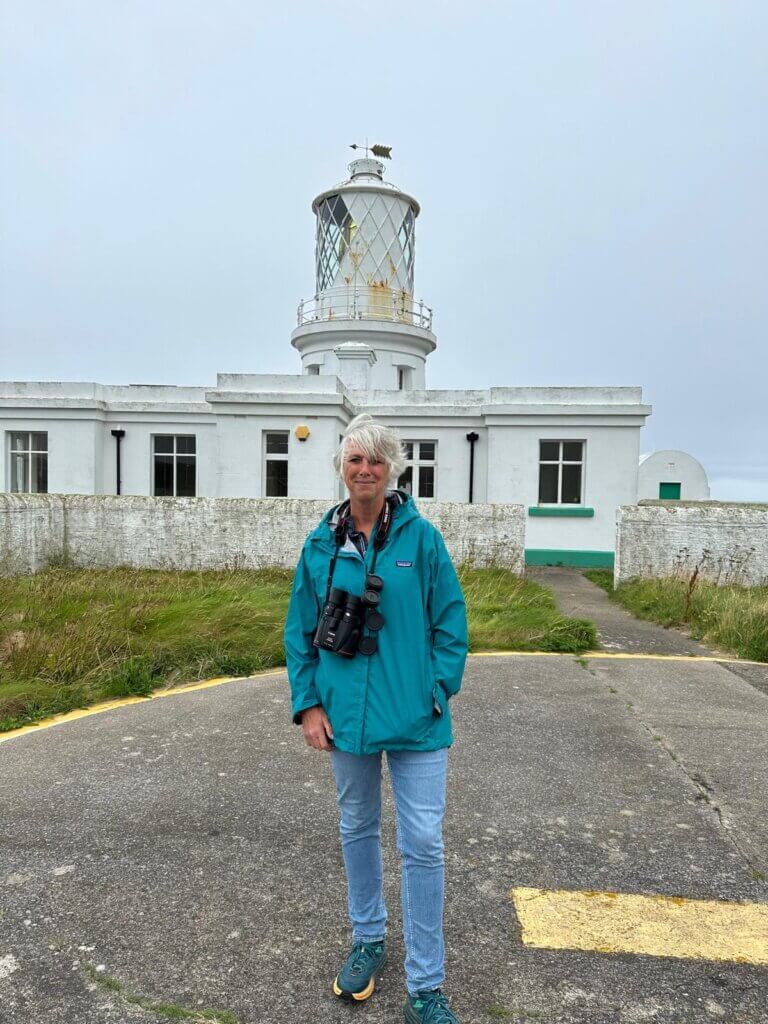
Gill Lewis is a multi-award-winning children’s author and former vet. She writes stories about animals and our human relationship with the wild world. Her books have won the US Green Earth Book Award, the German Prize for Environmental Youth Literature, and she has been awarded the Little Rebels Special Commendation for her contribution to political/ radical children’s literature.
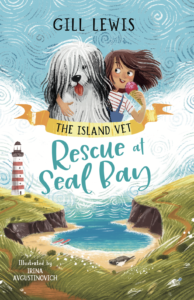 Her latest book, Rescue at Seal Bay was inspired by her move to West Wales and by the local community which strives to protect the wild creatures that share this remote and beautiful part of Wales. The story explores the need to raise awareness of human disturbance upon seals and other marine wildlife, to ensure people can enjoy using coastal waters whilst respecting wildlife at the same time.
Her latest book, Rescue at Seal Bay was inspired by her move to West Wales and by the local community which strives to protect the wild creatures that share this remote and beautiful part of Wales. The story explores the need to raise awareness of human disturbance upon seals and other marine wildlife, to ensure people can enjoy using coastal waters whilst respecting wildlife at the same time.
Rescue at Seal Bay is written by Gill Lewis, illustrated by Irina Avgustinovitch and published by Barrington Stoke Aug 2024.
Since Gill Lewis penned the story two years ago, the bay near where she lives has come under threat from a proposed development of an adventure hub, which, if planning is successful, could potentially damage the biodiversity of the bay forever. Thanks to Mark Avery for hosting this guest blog to discuss and raise questions about the protection of wildlife and regulation of the adventure tourism industry.
Is it time to shine a light on the adventure tourism industry and its detrimental impact upon wildlife?
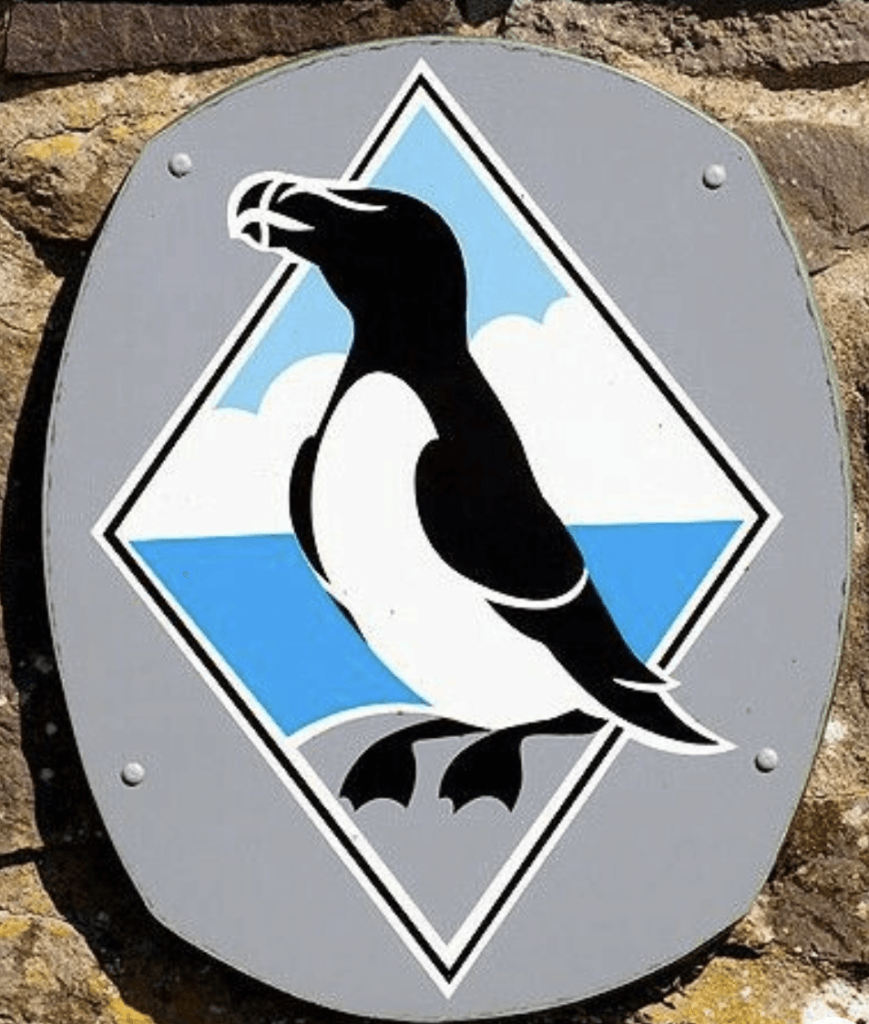
The razorbill is the emblem of the Pembrokeshire Coast National Park, the only coastal national park in Britain. Yet, with the expansion of thrill-seeking adventure tourism, will the increasing disturbance of wildlife diminish Pembrokeshire’s natural wealth and beauty? Many visitors come to see the wild side of Pembrokeshire, but will they still come if the wildlife isn’t here? Is thrill-seeking adventure tourism killing the razorbill that lays the golden egg of much-needed income from eco-tourism? And will future generations be denied opportunity to see these remarkable birds on the mainland coast?
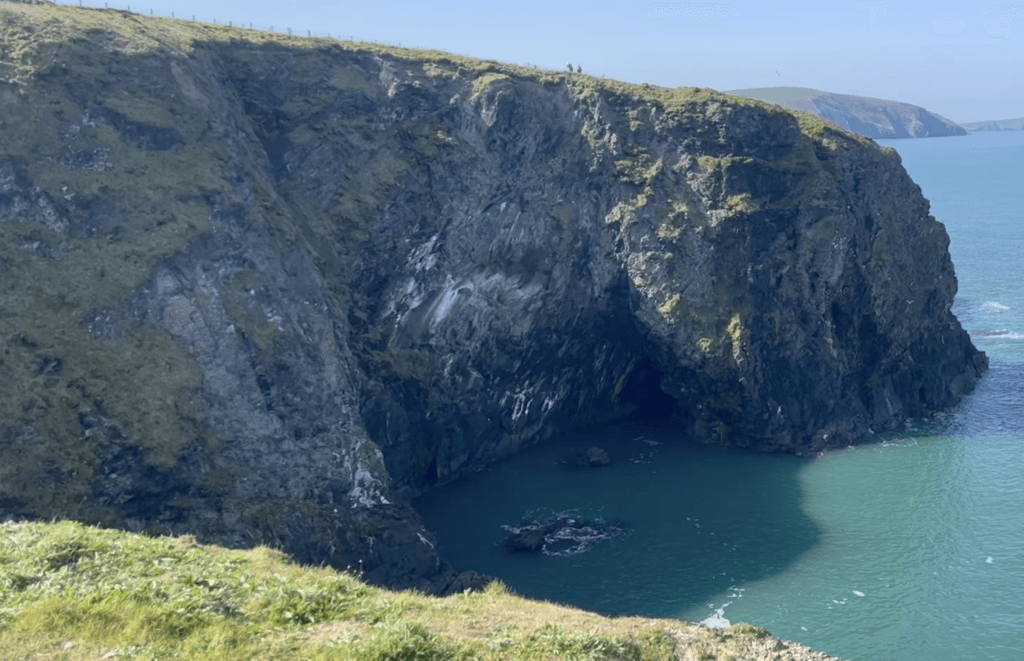
I’m lying on my belly near the cliff edge, above the sheer drop. The cliffs here curve in a horseshoe about a 100m at the widest point, with Careg Wylan (Gull Rock) protruding into the Irish Sea as a rocky spar. The pink thrift is coming in bloom, the sky is a rare blue after a long hard winter, and the sea is the emerald green of fairytales, frothing white where the swell heaves upon the rocks. This area, adjacent to Ceibwr Bay, offers shelter to nesting razorbills and guillemots from the storms that lash this North Pembrokeshire coast. The pungent scent of guano reaches me on an updraft, and I know that below me, out of sight, is a colony of some eighty or so razorbills and guillemots.
Further away and down to my right, is another but smaller colony of about 18 razorbills, tucked into the ledges of a natural crevice. We’re privileged to have these ‘penguins of the north’ nesting on the cliffs where visitors can view them. Not everyone can afford the boat trips to the islands to see these birds.
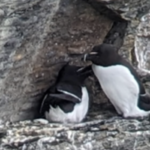
I’ve got to know this smaller colony over the past weeks from my vantage point. The razorbills are resting, calm and relaxed. Most seem to be sleeping. A few preen their feathers and one yawns wide, showing the bright yellow inside of its mouth. Another razorbill lunges at a jackdaw that has landed on the ledge, sending the intruder skyward, then settles back to rest, wings folded, blunt beak upturned.
But the peace here is broken by the whoops and shouts of coasteerers as they emerge from a sea cave into this avian amphitheatre. The people are less than 100m away and the birds bob their heads, craning to look to where the sound is coming from. It’s hard to tell. The voices echo and ricochet off the cliff walls. Then the coasteerers, bright in their helmets and buoyancy aids, swim towards the rock directly below the nesting auks. Four razorbills emerge from safe nesting places. The birds line up, head bobbing, wings flapping, agitated and distressed. The instructor scrambles up the cliff-base, followed by coasteering clients, less than 20m below the auks. One bird leaves the ledge, then another and another. A whole flush of birds. Two try to fly back to the ledge but curve away as loud splashes erupt from people jumping into the sea, followed by more whoops reverberating around the rocks. Only two razorbills remain. The jackdaw takes its chance and swoops into a nest crack, an opportunist search for eggs. Razorbills lay only one egg per year. One chance to raise a chick. Did they lose that chance just now?
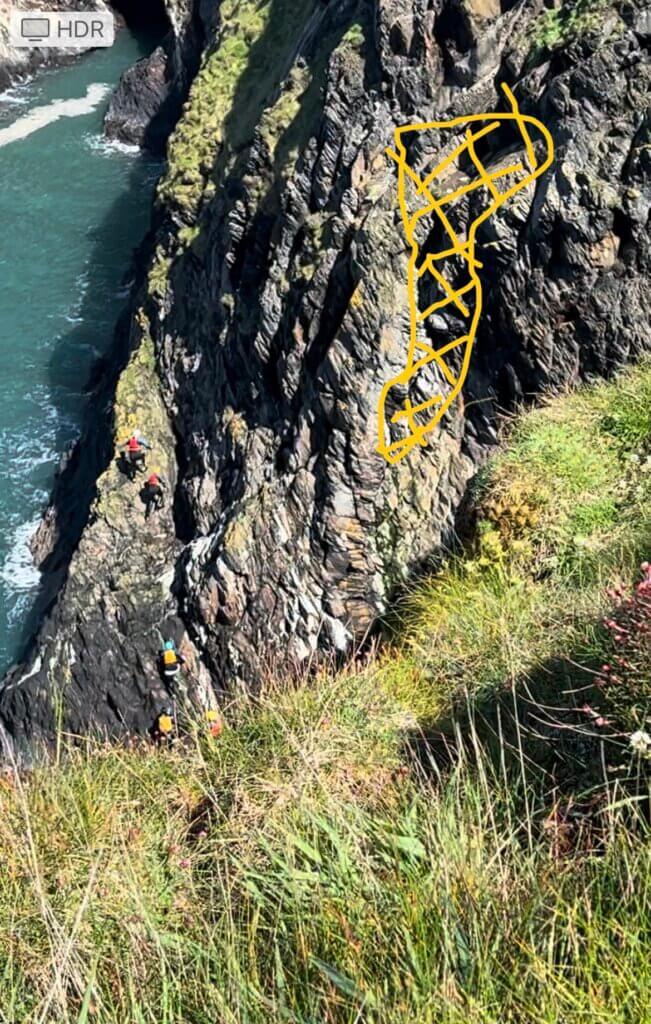
Studies have shown that the breeding success of razorbills is directly affected by human disturbance, and that would seem likely here. Eggs can be lost to damage or displacement if birds are forced to leave nest sites. Jackdaws and gulls take opportunity to take eggs and chicks if nests are temporality abandoned. Stressed adults may not be able to hunt as efficiently resulting in low survival rates of chicks. Razorbills are long-lived birds that are faithful to breeding sites and it is possible that despite the presence of razorbills here, reckless disturbance here may have affected breeding success over many, many years. With all the other survival pressures upon seabirds from climate change, pollution and bird flu, it may be that human disturbance here has tipped the balance and this colony cannot sustain itself.
This pattern of reckless disturbance of nesting auks has been repeated multiple times during the breeding season at Ceibwr by coasteering directly below the auks. Ceibwr Bay is an SSSI and part of the Cardigan Bay Special Area of Conservation – a European site of highest ecological importance – grey seals and a biogenic reef form part of the protected features.
Members of the local community of the village of Moylgrove have been trying to protect the area for over a decade, recognising and reporting the signs of disturbance to Natural Resources Wales (NRW), National Trust Cymru (NT) and Pembrokeshire Coastal Forum (PCF). Despite repeated requests for investigation, intervention and for coasteering to be stopped, the community feels their voice has not been heard. Our concerns have been recycled between these organisations in an eternal washing machine of failed communication, intransigence and shifting responsibilities.
Most people are aghast when I tell them that coasteering is occurring directly below nesting auks and causing behaviour consistent with regular reckless disturbance.
“It’s illegal! Inform the police.”
“Aren’t there marine codes of conduct to prevent this?”
“Tell the authorities protecting these sites. Surely, they can stop it.”
These are the usual responses, to which members of our community give a collective eye roll as we’ve heard it all before. We try to explain, yet again, that unbelievably, the marine life has very little protection. The auks have none at all.
Is it illegal to recklessly disturb the razorbills and guillemots?
No, is the short answer. Under the Wildlife and Countryside Act 1981 it is illegal to recklessly disturb Schedule 1 birds (eg choughs and peregrines). However, razorbills and guillemots are not schedule 1 and are only protected by law from intentional disturbance. The community has been complaining about reckless disturbance of auks for years, only to be told no laws have been broken.
However, under the Animal Welfare Act 2006, a person commits an offence if “they knew, or ought reasonably to know, that their act (that caused suffering) would have the effect or be likely to do so.”
So, commercial providers of adventure tourism disturbing nesting birds either;
- lack the basic knowledge and awareness of marine wildlife and are unaware of birds being disturbed.
- Or they are aware their actions are causing disturbance but are in contempt of animal welfare and the law.
Either option puts wildlife at risk, presenting the adventure tourism industry in a poor light.
Many commercial providers undertake the WiSE training scheme of how to behave around wildlife, and therefore it would be reasonable to assume that providers accredited with this training scheme should ‘reasonably know’ their actions would cause disturbance.
If auks were to be added to the special features of the SSSI, they would be protected from reckless disturbance by law, but when asked, NRW say they have no plans to add auks as special features.
Surely there are Marine Codes of Conduct to prevent this happening?
You would think so, wouldn’t you!
The majority of Marine Codes of Conduct and guidelines from local authorities, public and conservation bodies recommend staying 100m from nesting and rafting seabirds, and marine mammals.
This includes advice from: The Marine Codes of Conduct for Anglesey, Conway, Gwynedd, Ceredigion and North Wales. The same is true for Operation Seabird, WiSE training scheme, Defra, Seal Alliance, and the Cornwall Seal Group Research Trust.
Whilst all marine codes are voluntary, the 100m guideline is given to provide a safe distance of 100m, approximately the length of a football pitch, to prevent disturbance.

However, the Pembrokeshire Marine Code of Conduct differs markedly. There is no minimum distance given to stay from seabirds and only 50m from seals. The only advice states that if disturbance is seen, to not approach any further. However, in these cases, disturbance has already occurred. Furthermore, some visitors and commercial adventure providers might not know what disturbance looks like. Hence the 100m is a good initial guideline to set, to prevent disturbance happening.
How did the Pembrokeshire Marine Code of Conduct (PMCC) come about and why does it differ from the Marine Codes of Conduct for the rest of Wales?
The Pembrokeshire Marine Code of Conduct was pioneered by the Pembrokeshire Coastal Forum, a CIC company that states on its website that it ‘provides independent stakeholder engagement’ and ‘works to protect the coast and marine environment for current and future generations to enjoy.’ The PMCC was ‘developed by local operators, and other organisations working closely with the Pembrokeshire Coast National Park Authority and the National Trust.’
Yet, both RSPB Cymru and Welsh Wildlife Trusts have expressed concerns about the inconsistency of the PMCC with respect to other marine codes across Wales, resulting in wildlife being put at risk. This suggests a lack of engagement with these key stakeholders.
It begs the question, which stakeholders have been instrumental in constructing the PMCC?
Clearly, the Pembrokeshire Marine Code of Conduct, which gives no minimum distance from auks, has failed the colonies at Ceibwr where the auks are regularly disturbed. If the PMCC had stated the recommended 100m distance required from other marine codes of conduct, then the auk colony at Ceibwr might have been protected from disturbance and might possibly have grown substantially over the years.
Tell the authorities! Surely, they don’t allow this in a coastal national park?
Well, unbelievably, they do allow this.
Natural Resources Wales and National Trust Cymru have agreed a single access coasteering concordat for Ceibwr which gives an allowed route to access cliff bases directly below nesting auks. This is facilitated by the Outdoor Charter and coordinated by the Pembrokeshire Coastal Forum.
Yes, you did read that correctly. Coasteering is allowed directly below and within 20m of nesting auks.
The local community of Moylgrove has consistently raised concerns about disturbance to auks, grey seals and other wildlife by coasteering, as shown by minutes of community committee meetings going back over ten years. The community feels that the coasteering concordat and the Pembrokeshire Marine Code of Conduct are not fit for purpose, as evidenced by the multiple disturbances of auks this year alone. The management of the concordat appears to lack leadership, as there have been no apparent sanctions to providers who transgress of the rules of the concordat multiple times. One staff member of Pembrokeshire Coastal Forum told me that the mainland auks are not seen as significant as the auks on the Pembrokeshire Islands, and that it would be hard to stop coasteering at sites of SSSI as there are so many of them and it would reduce access to good coasteering locations. Understandably, the community feels there is bias from Pembrokeshire Coastal Forum towards the adventure tourism industry.
Grey Seals at Ceibwr

The razorbill breeding season is from March to July, and as they leave for the open seas, the grey seals will be arriving. Heavily pregnant females will look for safe beaches to haul out and have their pups from August to late November. The newborn seals are vulnerable to disturbance. Until they moult their white fluffy coat, they cannot swim well and are at risk of hypothermia, exhaustion and drowning. They need undisturbed time to feed from their mothers requiring the milk high in fat to triple their bodyweight in three weeks. After that time, their mothers will leave them to fend for themselves. Natural mortality rate in seals is high – 1 in 3 don’t survive the first six months, hence they need all the chances they can get.
Ceibwr Bay is less than 70m wide and it is impossible to stay 100m from a seal pup on the beach. It is likely that the presence of coasteering groups accessing the bay several times a day, nearly every day in August will prevent seals using the bay. Ones that do, risk high levels of disturbance. This section of coast is unforgiving with very few haul-out places accessible at all states of the tides. Ceibwr is a sanctuary for young pups.
In Ceredigion, the National Trust team shut Mwnt Beach to people when there are female and young seals present. But a different National Trust team responsible for Ceibwr are resisting actions to close Ceibwr beach if seals are present. This puts seals at risk of disturbance. Seals are special features of the Cardigan Bay Special Area of Conservation, and it is an offence to recklessly disturb a grey seal. It is hard to understand how the National Trust team responsible for Ceibwr have come to this justification. It’s even harder to understand why coasteering is allowed at this site where young seals will be learning to hunt and feed themselves close to the safe haul-outs at Ceibwr in the vital pupping and post weaning months from August through to late November.
Biogenic reef
The bay also has a biogenic reef, and trampling by coasteering has the potential to damage this rare structure, another protected feature of this Special Area of Conservation.
Proposed Adventure Hub
The lack of protection of the wildlife and the paucity of regulation of the adventure tourism industry have been brought into sharp focus by a proposed development of an adventure hub planned within the village of Moylgrove for winter 2024.
The hub, part funded by a UK Shared Prosperity Fund, plans to expand existing coasteering activities and other water-based sports from Ceibwr. The successful grant application was awarded without community consultation. A large majority of over 80% of local residents has opposed the development. Despite peaceful protest, some residents have been subjected to direct verbal abuse and also to unpleasant defamation on social media platforms from proponents of the hub. In all cases of intimidation, it has been noted that the victims have been women.
Initially, people objecting to the hub were told by the planning officers that their objections to the actual use of the hub and its effect upon the environment would not be considered, and that objections had to relate directly to the building itself. This was despite local residents referring to various policies in the Land Development Plan where it was felt that the use of the hub and potential impact on biodiversity of the bay should be considered. The community asked for the Future Generations Act to be taken into account too.
NRW offered no objection to the hub and National Trust declined to comment.
Fortunately, the community has representation from the brilliant team of the Environmental Law Foundation, (ELF), a UK charity that assists communities with environmental and public interest matters. ELF raised the issue that a Habitats Assessment must be undertaken to comply with UK law.
Under the Conservation of Habitats and Species Regulations 2017 (as amended) Nature Conservation duties for relevant stakeholders state that any proposal that is likely to directly or indirectly damage a site European Protected Site, regardless of whether or not the proposal is within the SAC boundary, it must be properly assessed for its impacts on the protected site, including its protected features. That is enshrined into law as the precautionary principle; if the applicant cannot prove that there will be no adverse effects the proposal must be refused.
It raises the question as to why it needed to take lawyers working for ELF to ensure the rule of law is followed. Why was a Habitats Assessment not part of the original planning process? Why didn’t NRW or NT raise this vital issue? Why has the wildlife at this site of high European importance been failed by the bodies responsible for protecting it?
Following the ELF objection to planning, Rebecca Blackman – Planning Ecologist – also raised concerns and stated a Habitats Assessment must be done. In addition to the protection of a long-eared bat roost at the hub site, she also referred to the importance of Ceibwr as a significant seabird breeding site and seal pupping area, stating the need for mitigation to avoid disturbance to pupping beaches during the pupping season.
Dr Rob Thomas, a leading expert in seabirds and seabird behaviour, visited Ceibwr and also viewed videos of coasteering close to the nesting auk colonies. In a comprehensive statement he concluded that the behavioural responses of the auks were consistent with disturbance from coasteering activities, and that this could be very likely to have a negative impact upon breeding success of the colony. He also raised the question that whilst Schedule 1 choughs and peregrines breed well further along the coast, it could be that regular reckless disturbance, as seen at Ceibwr, prevents them using suitable sites where coasteering currently occurs.
His concluding statements include:
Urgent questions to be addressed, requiring adequate data and evidence-based decisions, therefore include the following:
- Are breeding auks being intentionally disturbed? This would seem to be the case given that (a) the coasteering activities at Ceibwr Bay appear to disturb the breeding auks, and given that (b) the coasteering company directors have repeatedly been notified of the concerns surrounding the disturbance of breeding auks, yet they nevertheless have intentionally continued these activities.
- Are breeding Schedule 1 bird species being recklessly disturbed? This would seem to be the case if (a) coasteering was being carried out recklessly with regards to Schedule 1 species (Peregrine Falcon and Red-billed Chough) which currently do not breed in otherwise highly suitable breeding habitat at Ceibwr Bay, presumably due to the current level of disturbance, and (b) would certainly be the case if either of these species were to attempt to breed and coasteering activities continued unchanged.
My recommendation is therefore that any continuation or expansion of coasteering activities at Ceibwr Bay needs to be paused until good quality data on both behavioural and demographic effects of coasteering on breeding auks can be collected, and until such data are used for evidence-based assessment of the above questions.
As of the current date of writing (August 2024) the community is anxiously awaiting the outcome of the deferred planning meeting which will determine the future of the hub. If planning is granted, it is a decision which could irrevocably damage the biodiversity of this area forever.
The future of the auks and seals?
This situation has highlighted the failures of the authorities to protect the flora and fauna of a site of high ecological importance. It has also highlighted the lack of independent regulation of adventure tourism. Ceibwr presents a test case. If coasteering is allowed to run roughshod across rare biogenic reef and continue to recklessly disturb the seabirds and seals at this SSSI and SAC, then where in the UK will nature be safe from this form of exploitation?
Adventure tourism has a place in Wales but should be carefully managed. Much has changed over the past 20 years and adventure tourism is expanding exponentially, with the Outdoor Charter of PCF seeking to find ever more areas to exploit. The pressures on wildlife are increasing exponentially too, with effects of man-made climate change, disease and from human pollution and disturbance. The management of adventure tourism in Wales needs a robust overhaul to ensure we are protecting wild habitats to restore nature and reach the 30 by 30 targets set by the Welsh and other Governments.
So, I ask Pembrokeshire Coastal National Park, who are you in thrall to? Thrill-seeking adventure tourism, or the astonishing wildlife and the many visitors who come to see it? If adventure tourism is favoured over eco-tourism, we may well lose the wildlife and the much-needed income that ecotourism brings with it. In favouring adventure tourism, the Pembrokeshire Coastal National Park may kill the razorbill that lays its golden egg.
Only time will tell if the right decisions have been made to keep Ceibwr wild. But this community will know that we have tried our best to restore and protect the biodiversity of the bay for the many visitors who come to see the wildlife and share this remote wild beauty, and ultimately for the future generations who deserve a chance to see it.
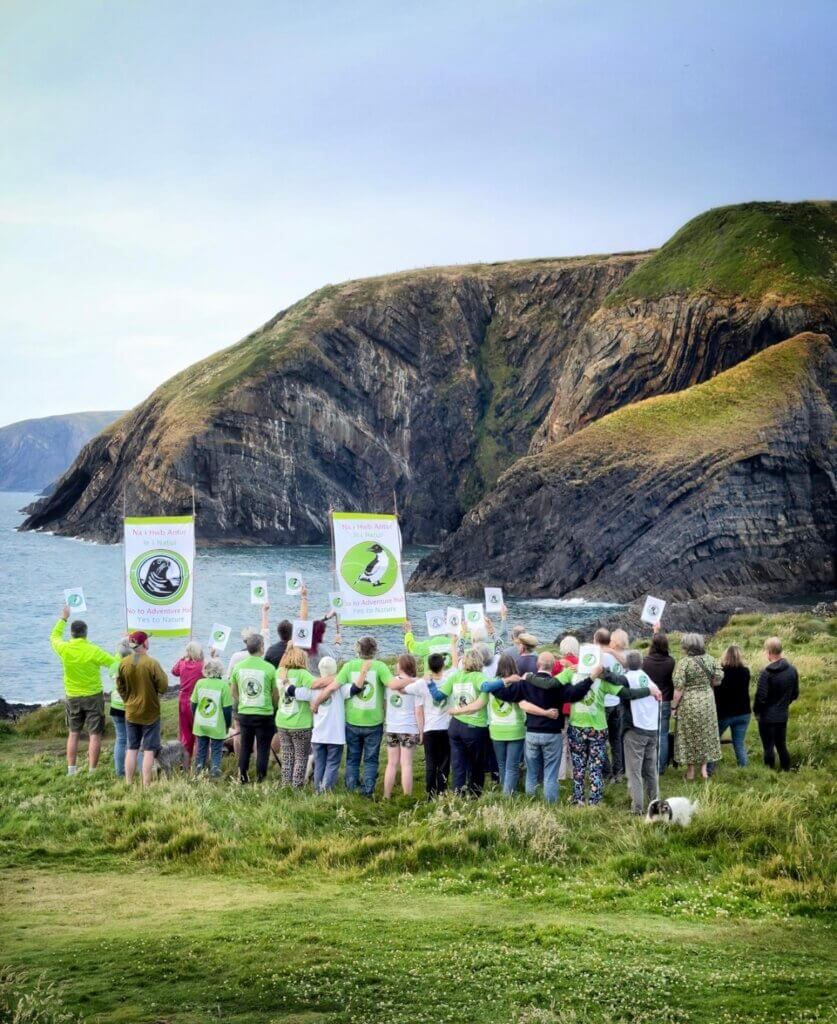
[registration_form]
I have lived not far from this area for 30 years and completely agree with this excellent blog post. Both on the coast and the river Teifi there are now too many companies taking far too many people out for ‘adventure tourism’ with the resultant disturbance to wildlife.
A heartfelt and accurate write up of what is happening at Ceibwr and Moylegrove. Why are the Authorities looking the other way?
I fully agree with all of this written by Gill. I live in Moylgrove and have been an ecologist all my working life. We have to stop being in thrall to money and adventure activities constantly and start putting Nature first. Nature desperately needs areas where biodiversity can be allowed to breed and increase quietly and away from noisy human activities. There are fewer and fewer of these areas left and we need to start saying no to commercialism and yes to biodiversity and the right of all living creatures to live peacefully and undisturbed.
Conservation organisations and PCNPA: stand up and be counted and say ‘no’ to this. We’re at tipping point now and Ceibwr needs our help to be one the first in a spearhead of many special Spaces for Nature…
Gill’s piece altogether highlights the unsustainable impact of people-disturbances on the seals and birds in their habitats along crucial areas of the North mainland coast of Pembrokeshire during the breeding season and other times of the year. The question is, as we have Ramsey and Skomer Island, is the wildlife of the North mainland coast, despite its vital wildlife habitats and species, not adequately protected because it is considered expendable? It’s hard to fathom otherwise why there are no realistic measures in place, as elsewhere, to ensure that in these key habitats -seals and cliff nesting birds, including shorebirds, are not included in proper protection. After all, it does not matter whether it’s the North mainland coast or an island; wildlife habitats need equal protection. It would seem only a minority of stakeholders get a say. But in reality, we are all ‘stakeholders’ of nature, and it is about time our collective voices on behalf of the seals, dolphins, porpoises and birds are listened to and counted.
‘The question is, as we have Ramsey and Skomer Island, is the wildlife of the North mainland coast, despite its vital wildlife habitats and species, not adequately protected because it is considered expendable?’
A good question. This is perhaps emblematic of the failure of the SSSI system across the country as a whole. We have sites (supposedly) recognised and protected for their importance for one species or another and this has meant that the wildlife in the rest of the countryside has become de facto expendable with the result that much of our wildlife is in decline. If we always only protect the very best bit we can rapidly end up with very little.
I hope that Ceibwr Bay and similar sites in Pembrokeshire will receive better protection and that bodies such as NT and NRW and the National Park show a bit more commitment to wildlife.
This is in stark contrast to the climbing world where the over arching bodies publish annual bird nesting updates ruling specific climbing areas off limits. Coasterring is a much younger activity and it’s going to take time for it to mature in the way that other activities have.
That’s very interesting.
How could I find out more about that – via the BMC? – and can it be regulated?
Nesting bird areas should be off limits to coasteering. It’s unbelievable that a coasteering concordat with a route directly below nesting auks has been agreed by National Trust.
An introduction of activities likely to cause disturbance to a feature of a SSSI will require the landowner to get consent from NRW. NRW can put in place conditions in the consent around the timing and specific location of proposed activity. This should provide some protection against disturbance for the seal pupping and haul out sites. Unfortunately the auk colony is not a SSSI feature at this site. (It is about significance of a particular species/ population within the county). W&C Act can only be used if it can be shown that the nest was knowingly disturbed. All observations of disturbance should be reported to NRW with locations, dates and photographs if possible.
Hello Jenny – yes and herein lies the problem.
The coasteering concordat is agreed by NRW and NT and allows a route which goes directly beneath nesting auks.
The coasteering area is accessed via NT owned land.
NRW and NT consent to it.
However, the private landowners either side of the NT land have done the responsible thing and denied access to adventure tourism providers on their land (this is above mean high tide) because they recognise their responsibilities of owning an SSSI – the foreshore has different rules.
You will not believe this but it is true. All council determinations (decisions) must go before the full council. A planning committee can recommend but not decide. This is good law because it stops a small group being bribed by developers.
The Local Authorities (Functions and responsibilities) England Regulations 2000
The schedule states that a planning determination cannot be made by a committee. Please respond.